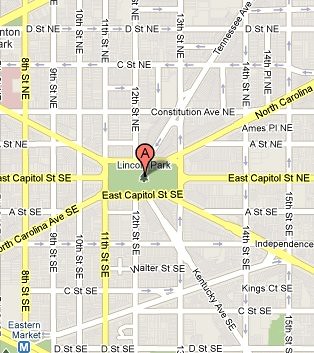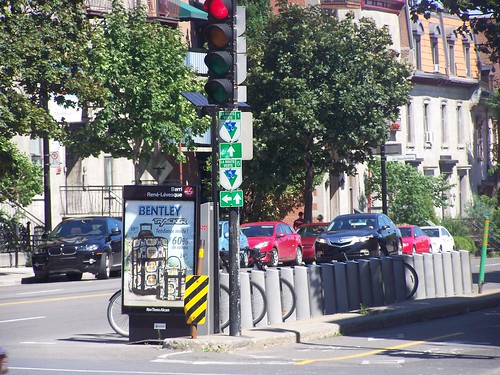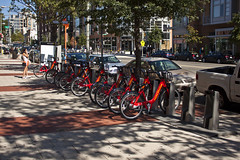Bicycle sharing location decisionmaking in DC
(I hate to write about this, because the firm I am a principal with on selling bicycle sharing systems just lost out to Alta/Bixi in Chattanooga, even though we probably had a superior programmatic proposal. That being said, the Public Bicycle Sharing System group has done a great job in setting up a robust bicycle sharing platform.)

There is an "uproar" about the location of a bicycle sharing station adjacent to "Lincoln Park" (a rectangular square in Eastern Capitol Hill between 11th and 13th Streets, bounded by East Capitol Street and Massachusetts Avenue). Some residents don't want a station located on the park (right now the National Park Service, which controls the space, doesn't allow it anyway) or on an abutting reservation (what we might call weird interstitial pieces of land created by the intersection of diagonal avenues with the orthogonal nature of the square-based street grid).
Washcycle and Greater Greater Washington have been covering the story, which has also been discussed on local listservs, some of which I am still subscribed to, and on which I wrote this (with some edits):
the thing that is not done very much in planning efforts, and is difficult to do besides, is to articulate simultaneously what we might call citywide concerns/goals/objectives, "neighborhood" concerns/goals/objectives, and immediate resident concerns/goals/objectives and create a process to resolve them.
In social psychology this is called boundary spanning and it is very difficult, because conflict is built into the system and situations at the outset, and it makes planning jobs very very difficult for planners, because they have to make congruent what can be very difficult choices.
Usually what happens is that planning efforts kowtow to residents without adequately differentiating and outlining and prioritizing what I call citywide concerns.
In the case of bikesharing, the "citywide concern" is about creating a _network_ of bicycle stations that serve residents, workers, and visitors simultaneously, by locating stations in places (activity centers) that are in high use/high demand, places like parks and squares, commercial districts, schools, public facilities, transit stations, etc.
This is particularly important because poorly placed stations and gaps in the network significantly reduce the overall usefulness of the system and reduce the likelihood of success. SInce you're spending millions of dollars on such systems and because in an automobile centric culture, there are many people and interest groups waiting in the wings to criticize the system for any and all failures (i.e., this blowhard piece from the Competitive Enterprise Institute fails to acknowledge the importance of vast subsidies to automobility to ensuring the widespread use of automobiles, and the competitive disadvantages this puts on other modes).
By not outlining this criteria and its importance in a very direct and forward fashion, these types of conflicts are preordained.
(It's a similar problem with bus service. Every neighborhood wants a "circulator" but service of that frequency is supposed to meet certain conditions. But because those conditions are not set and clarified and communicated, poor decisions with significant negative financial implications end up being the typical end.)
I agree with concerns about viewsheds but typically there are locations where infrastructure such as a bicycle sharing station can be accommodated. In Montreal, where bikesharing is widely deployed, there are bikesharing installations on the outskirts of parks, and the value and necessity of proximity and proper placement of stations to maximize use isn't questioned. (I am specifically referring to the Old Port and to Park LaFontaine, which I witnessed myself.)
However, most of the Montreal bikestations are placed in the public space, in spaces that had once been used for parking. Certainly, it would be very easy to not take up park space or reservation land in the vicinity of Lincoln Park by instead using any of the many street parking spaces abutting the Lincoln Park rectangle, on East Capitol or Massachusetts Avenue, or within 50 feet of those streets on any of the "side streets" (12th, Kentucky, Tennessee) emanating from the Park.
------
What I did not include in the listserv posting is this. If DC had a master transportation plan comparable to that of Arlington County, where optimal mobility is prioritized as a leading goal of the plan, then space for bikesharing stations would be prioritized over that for motor vehicles, in terms of use of scarce public space.
So in the photo accompanying this blog entry (by thisisbossi), where the bikesharing station is on the sidewalk, instead it would likely be in the street, taking up spaces which would have gone to parking. For the most part, that's how it is done in Montreal.
This bicycle sharing station on Rue Berri at Rene Levesque Boulevard in Montreal uses up space that had been previously dedicated to street parking, not scarce sidewalk space.

Labels: bikesharing, civic engagement, land use planning, neighborhood planning, transportation planning, urban design/placemaking




0 Comments:
Post a Comment
<< Home